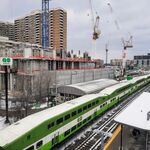The Gardiner Expressway: A lump of coal in Toronto’s stocking
The proverbial lump of coal in Toronto’s stocking this year? As much as a half-billion-dollar repair bill for the crumbling Gardiner Expressway.
As part of their 2013 budget debate, council is considering ratcheting up their annual maintenance spending on the lakeside highway from $10 million to more than $50 million a year over the next 10 years. Under the new proposal, about 17 cents of every dollar spent on transportation projects over the next decade will go toward rehabbing the highway.
Meanwhile, the other 5,600 kilometres of roadway in Toronto are actually projected to deteriorate as efforts are focused on the 18-kilometre Gardiner. The capital plan shows the repair for major roads across Toronto increasing by a factor of three between now and 2022. And those roads are important — for all the attention it gets, a 2009 study revealed that only eight per cent of inbound morning commuters used the Gardiner to get downtown.
The numbers don’t lie. This highway’s a money pit.
Debates about the future of the Gardiner always give way to trumped-up hysteria about the “war on the car.†But costs have gotten so out of control that this is no longer a debate about urbanism or mobility. It’s about money. Full stop.
Fans of the expressway status quo will point to the lack of alternatives. And they’ve got a point. It’s not as if current service levels on GO Transit or the TTC can accommodate many more bodies at rush hour. And unless the plan is to break out the bulldozers Sim City-style, we’re not going to be able to expand other roads, even if we wanted to.
So what’s the answer? Two things.
First, the city should return to a 2009 study on tearing down or modifying the section of the highway east of Jarvis Street — a study that mysteriously stalled after Mayor Rob Ford took office. This stretch, which was engineered with extra capacity for expansion that never happened, accounts for more than $200 million of the total repair forecast. To even consider spending money rehabbing this section with the study incomplete is downright irresponsible.
Second, let’s look to road tolls as a means of paying for repairs on any parts of the highway we can’t afford to lose. Not only will this leave room in the city’s capital plan for more important projects, it’ll also make things more equitable.
Since even before Premier Mike Harris downloaded more highway costs to the municipality in the ’90s, 905-ers haven’t been paying their fair share — it’s high time for everyone who uses the highway to pay up.
At the very least, the solution can’t be to just move forward blindly.
Toronto’s got to take its foot off the gas and consider where this road is taking us.
Matt Elliott




